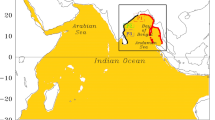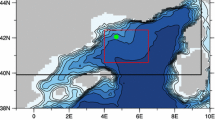Abstract
Vertical thermohaline structure in the southeast part of the Baltic Sea is complicated: The salinity field has two layers due to the general estuarine circulation, while the water temperature stratification changes seasonally from two-layered to three-layered. Simulation of the re-stratification processes in such a basin is still a challenging problem, even for the most advanced models. In this study, using a comparison with the independent field data, we have examined how well the structure of the Baltic Sea Cold Intermediate Layer (CIL) is reproduced by the Copernicus Marine Environment Monitoring Service (CMEMS) reanalysis data. It was found that the water salinity within the CIL and the halocline is overestimated, and the upper CIL boundary (the thermocline) in the reanalysis data is considerably shallower than that in the field data. These conclusions are similar to other studies comparing model and field data in the Baltic Sea for various applications. The reanalysis data demonstrate certain deviations in the water temperature, salinity, and depth values at the CIL upper and lower boundaries. However, the general structure of the CIL is reproduced well, including its salinity-homogeneous and salinity-gradient sublayers. Moreover, the T-S diagrams indicate that the salinity-gradient sublayer in the south-eastern and central basins in summer contains waters similar to those observed within the upper mixed layer in spring in the south-western sea basins. This confirms the applicability of the CMEMS reanalysis (with certain caution regarding the temperature/salinity/depth values) for the investigation of such a complicated process as the formation of the Baltic CIL in spring when the seasonal vertical mixing ceases and denser waters from the eastern part of the sea are expected to renew the lower part of the CIL in the Baltic Proper.





Similar content being viewed by others
References
Bagaev, A. V., Bukanova, T. V., & Chubarenko, I. P. (2021). Spring cold water intrusions as the beginning of the cold intermediate layer formation in the Baltic sea. Estuarine, Coastal and Shelf Science., 250, 107141. https://doi.org/10.1016/j.ecss.2020.107141
Chubarenko, I. P., Demchenko, N. Y., Esiukova, E. E., Lobchuk, O. I., Karmanov, K. V., Pilipchuk, V. A., Isachenko, I. A., Kuleshov, A. F., Chugaevich, V. Y., Stepanova, N. B., Krechik, V. A., & Bagaev, A. V. (2017). Spring thermocline formation in the coastal zone of the southeastern Baltic sea based on field data in 2010–2013. Oceanology, 57(5), 632–638.
Chubarenko, I., & Stepanova, N. (2018). Cold Intermediate Layer of the Baltic Sea: Hypothesis of the formation of its core. Progress in Oceanography, 167, 1–10. https://doi.org/10.1016/j.pocean.2018.06.012
Cyr, F., Bourgault, D., & Galbraith, P. S. (2011). Interior versus boundary mixing of a cold intermediate layer. Journal of Geophysical Research - Oceans, 116, C12029. https://doi.org/10.1029/2011JC007359
Döös, K., Meier, H. E. M., & Döscher, R. (2004). The Baltic haline conveyor belt or The overturning circulation and mixing in the Baltic. Ambio, 33(4–5), 261–266.
Hordoir, R., Axell, L., Löptien, U., Dietze, H., & Kuznetsov, I. (2015). Influence of sea level rise on the dynamics of salt inflows in the Baltic Sea. Journal of Geophysical Research - Oceans. https://doi.org/10.1002/2014JC010642
Izhitskiy, A. S., Zavialov, P. O., Roget, E., Huang, H. P., & Kurbaniyazov, A. K. (2014). On thermohaline structure and circulation of the Western Large Aral Sea from 2009 to 2011: Observations and modelling. Journal of Marine Systems, 9, 234–247.
Janssen, F., Schrum, C., & Backhaus, J. O. (1999). A climatological data set of temperature and salinity for the Baltic Sea and the North Sea. Deutsche Hydrogaphishe Zeitschrift, 51(9), 5–245.
Korotaev, G. K., Knysh, V. V., & Kubryakov, A. I. (2014). Study of formation process of cold intermediate layer based on reanalysis of Black Sea hydrophysical fields for 1971–1993. Izvestiya, Atmospheric and Oceanic Physics, 50(1), 35–48.
Lascaratos, A., Roether, W., Nittis, K., & Klein, B. (1999). Recent changes in deep water formation and spreading in the eastern Mediterranean Sea: A review. Progress in Oceanography, 44, 5–36.
Leppäranta, M., & Myrberg, K. (2008). Physical Oceanography of the Baltic Sea (p. 370). Springer.
Madec, G. & the NEMO team (2008). NEMO ocean engine Note du Pôle de modélisation, Institut (IPSL), France, No 27, ISSN No 1288–1619.
Menna, M., & Poulain, P. M. (2010). Mediterranean intermediate circulation estimated from Argo data in 2003–2010. Ocean Science, 6, 331–343.
Oguz, T., & Besiktepe, S. (1999). Observations on the Rim Current structure, CIW formation and transport in the western Black Sea. Deep-Sea Research I, 46, 1733–1753.
Omstedt, A., & Axell, L. B. (1998). Modeling the seasonal, interannual, and long-term variations of salinity and temperature in the Baltic proper. Tellus, 50A, 637–652.
Pemberton, P., Löptien, U., Hordoir, R., et al. (2017). Sea-ice evaluation of NEMO-Nordic 1.0: A NEMO–LIM3.6-based ocean–sea-ice model setup for the North Sea and Baltic Sea. Geoscientific Model Development, 10, 3105–3123. https://doi.org/10.5194/gmd-10-3105-2017
Rak, D. (2016). The inflow in the Baltic Proper as recorded in January–February 2015. Oceanologia, 58(3), 241–247. https://doi.org/10.1016/j.oceano.2016.04.001
Rak, D., & Wieczorek, P. (2012). Variability of temperature and salinity over the last decade in selected regions of the southern Baltic Sea. Oceanologia, 54(3), 339–354. https://doi.org/10.5697/oc.54-3.339
Rousset, C., Vancoppenolle, M., Madec, G., et al. (2015). The sea ice model LIM3.6: Global and regional capabilities. Geoscientific Model Development, 8, 2991–3005. https://doi.org/10.5194/gmd-8-2991-2015
Stanev, E. V., Bowman, M. J., Peneva, E. L., & Staneva, J. V. (2003). Control of Black Sea intermediate water mass formation by dynamics and topography: Comparisons of numerical simulations, survey and satellite data. Journal of Marine Research, 61(1), 59–99.
Stanev, E. V., & Staneva, J. V. (2001). The sensitivity of the heat exchange at sea surface to meso and sub-basin scale eddies. Model study for the Black Sea. Dynamics of Atmospheres and Oceans, 33, 163–189.
Staneva, J. V., & Stanev, E. V. (1997). Cold water mass formation in the Black Sea. Analysis on numerical model simulations. In E. Ozsoy & A. Mikaelyan (Eds.), Sensitivity to Change: Black Sea, Baltic Sea and North Sea (Vol. 27, pp. 375–393). Kluwer Academic Publishers.
Stepanova, N. (2017). Vertical structure and seasonal evolution of the cold intermediate layer in the Baltic Sea. Estuarine, Coastal and Shelf Science, 195, 34–40. https://doi.org/10.1016/j.ecss.2017.05.011
Stepanova, N. B., Chubarenko, I. P., & Shchuka, S. A. (2015). Structure and evolution of the Cold Intermediate Layer in the southeastern part of the Baltic Sea by the field measurement data of 2004–2008. Oceanology, 55(1), 25–35.
Stepanova, N., & Mizyuk, A. (2020). Tracking the formation of the gradient part of the southeastern Baltic Sea cold intermediate layer. Russ. J. Earth Sci., 20, 3005. https://doi.org/10.2205/2020ES000700
Stipa, T. & Vepsäläinen, J. (2002). The fragile climatological niche of the Baltic Sea. Boreal Env. Res. 7: 335–342. ISSN 1239–6095
Tuomi, L., Myrberg, K., & Lehmann, A. (2012). The performance of the parameterisations of vertical turbulence in the 3D modelling of hydrodynamics in the Baltic Sea. Continental Shelf Research, 50–51, 64–79.
Webb P. (2021) Introduction to Oceanography. Pressbooks. CC BY (Attribution). https://rwu.pressbooks.pub/webboceanography/ (date of acquisition 21.07.2022)
Acknowledgements
The authors are grateful to many scientists and organizations which perform measurements and maintain the data exchange network in the Baltic Sea region. In particular, the data of the LUKOIL monitoring program (cruises of R/V “Professor Shtokman”) were kindly provided for scientific research by KaliningradMorNeft, and the data from the Arkona Basin Buoy – by the Federal Maritime and Hydrographic Agency (www.bsh.de). Collection, processing and analysis of field data were performed in the framework of the state assignment (theme No. FMWE-2021-0002).
Author information
Authors and Affiliations
Corresponding author
Ethics declarations
Conflict of interests
The authors declare that they have no known competing financial interests or personal relationships that could have appeared to influence the work reported in this paper.
Additional information
Publisher's Note
Springer Nature remains neutral with regard to jurisdictional claims in published maps and institutional affiliations.
Rights and permissions
Springer Nature or its licensor holds exclusive rights to this article under a publishing agreement with the author(s) or other rightsholder(s); author self-archiving of the accepted manuscript version of this article is solely governed by the terms of such publishing agreement and applicable law.
About this article
Cite this article
Stepanova, N., Mizyuk, A. On the Applicability of CMEMS Reanalysis Data for Investigation of the Cold Intermediate Layer in the South-Eastern Part of the Baltic Sea. Pure Appl. Geophys. 179, 3481–3492 (2022). https://doi.org/10.1007/s00024-022-03130-9
Received:
Revised:
Accepted:
Published:
Issue Date:
DOI: https://doi.org/10.1007/s00024-022-03130-9




